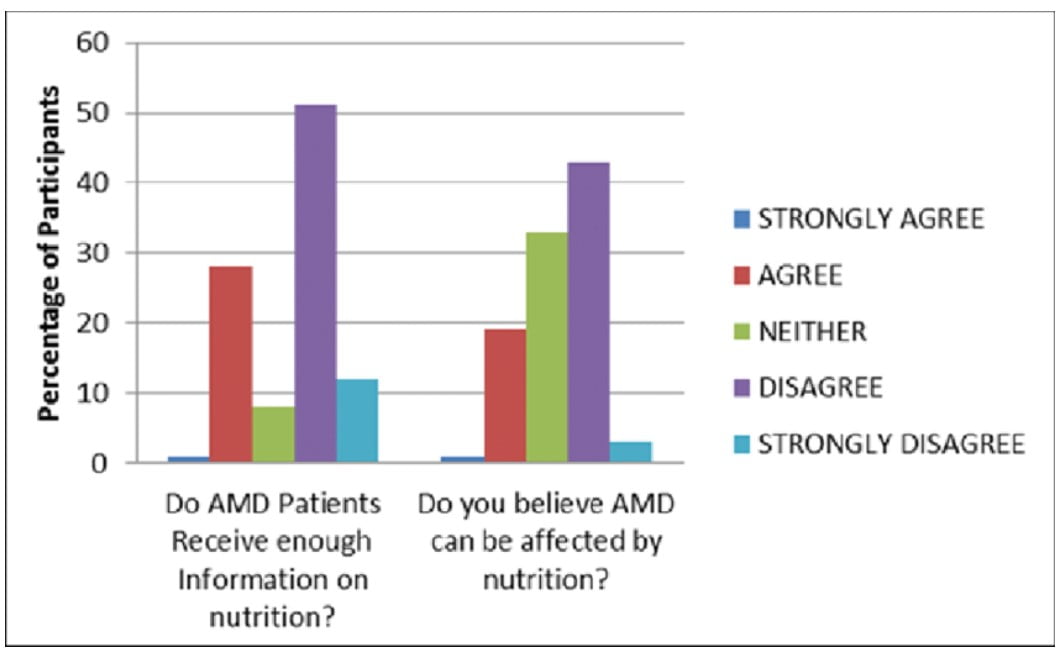Macular degeneration is a chronic eye disorder. It was once ranked as the third most common cause of moderate to severe visual impairment globally. A meta-analysis and systematic review found that it affects 8.7% of the world population. Further:
- As many as 11 million people in the US have some form of this disease.
- This number could end up in a whopping 22 million by 2050.
- Global prevalence of any ARMD stage may reach 288 million by 2040.

Image Source: https://www.researchgate.net/figure/Knowledge-of-AMD-AMD-age-related-macular-degeneration_fig3_270724598
Wet or exudative or neovascular degeneration is the most common cause of visual impairment in the senior population (60 years or older). Approximately 10% of all patients with ARMD (age-related macular degeneration) anyway develop a neovascular disease.
You may experience blurred vision or a blind spot in the central visual field. Blood vessels start growing from underneath the macula and fluids and blood leak into the retina. It distorts the sight and forms a scar. You may also experience blurry and wavy vision. Progression makes it worse and causes 90% legal blindness. The global cost of treating this visual impairment stands at $255 billion. So, it is a good idea to know a few preventive steps.
1. Maintain a Nutritious Diet
Nutrition plays a key role in the onset of macular degeneration, and it is possible to lower the risk by eating right.
A high glycemic diet is linked to ARMD onset and progress. These include white bread, white rice, potatoes, sugary drinks and processed items like corn chips or pretzels. Try to add leafy green vegetables like kale and spinach to your plate. These are rich in antioxidants and can protect the body against cellular damage. Fewer free radicals in the body might reduce the chances of eye diseases. Compliant foods like fruits, nuts and seeds, whole grains, dairy, herbs and spices and legumes are a must. Eat plenty of fat-rich fish like salmon, sardines and mackerel twice a week to further minimize the risk of ARMD. Consult your health specialist to see if supplements like AREDS2 vitamins or lutein and zeaxanthin work for you.
2. Maintain a Healthy BMI
Medical Science Journal published a study in August 2019 which says high body mass index and waist circumference are the signs of obesity and increase the chances of ARMD. A BMI over 25 is considered ‘overweight’ and over 30 as ‘obese’.

Image Source: https://time.com/5751551/us-obesity-by-state/
Unhealthy weight leads to early or intermediate macular degeneration that may lead to a more advanced stage. Consume more lean proteins like red meat and cut down on fatty foods to lower the risks of obesity and age-related macular degeneration before the golden years hit.
3. Stop Smoking Altogether
Being heavily exposed to tobacco smoke enhances the odds of degeneration. It causes less lubrication in the eye which is irritating. Smokers are 3-4 times more likely to develop this condition than non-smokers. The situation may worsen if you wear lenses. But the good news is that tobacco craving is a modifiable risk factor. Try nicotine replacement therapy, avoid triggers, chew on gums and try physical activities like kneed bends and squats daily. All of these can help the urge pass in the next 5-10 minutes.
4. Reduce Sun Exposure
Staying in the sun without proper covering like hats for a long period can increase the odds of macular degeneration. The rays hit your eye directly which is hurtful for the retina. This is because skin sensitivity to sunlight combined with green or blue iris color could prove dangerous. The Chesapeake Bay Waterman Study says that fishermen exposed to sunlight regularly might develop ARMD. So, keep your eyes shaded with sunglasses labeled UV 400 even on cloudy days.
5. Check your Family History
First-degree relatives can pass down macular degeneration to you. So, keep a check on tell-tale signs like the need for bright light, increased blurriness, problems adapting to low light levels and trouble recognizing faces. Visit the ophthalmologist as early as possible to avoid a delay in treatment. An accurate diagnosis is the first step to keep the disease under control and slow down the progress, stabilize vision and even restore it to some extent.
Test with an Amsler grid and maintain steady blood pressure. Sleep well since tired eyes are objective signs of increased risk of macular degeneration. Get an eye exam once a year to identify signs and take immediate action, if necessary.





